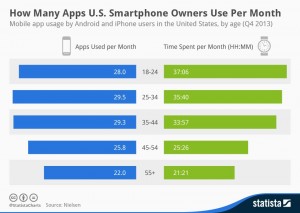Estimated reading time: 4 minutes

The No. 1 commodity in the world is information.
Today, information is more accessible than it has ever been, with mediums such as: the internet (laptops, tablets, smartphones), television (Hulu, Netflix), internet and traditional radio, magazines and newspapers. The expectation is to find what you need instantly.
In today’s business world, if you aren’t meeting this expectation you risk losing customers to your competitors. The sad thing is, it won’t necessarily be on account of superior products or services, but rather, that they’ve made doing business with them easier and more convenient.
What’s more, people are expecting to have access to your company profile on-the-go. In fact, 98% of all business users have a mobile device, and the average person checks their mobile device a whopping 110 times per day! They use their mobile device to check things such as: social media, news, e-mail, calendars, weather, web searches, and ultimately what we’ll be discussing – checking native mobile apps.
Before we begin, let’s get a better understanding of how much time people spend on average looking at or using apps on their mobile devices.
As the diagram shows, the notion that apps are only used by teens or young adults for entertainment purposes and not by business professionals is false. People of every age and for every reason can and will be using apps to access their favorite businesses on-the-go. In business, developing and maintaining an app could be the deciding factor on your company’s long term success.

So how could you use an app for your business? First, you would want to define the audience. To generalize, there are two types of people who would view your app that would be of benefit to your business:
- A prospect, or someone who has yet to do business with you. For these people, you would want to give them information about your company, along with contact info so they can follow up. You may also think about adding some sort of registration process (so they would have to “sign in”) in order to collect their contact info as well.
- The other type of person who would be visiting your app would obviously be existing customers, and the goal would be to get them to keep coming back to your app.
How do you do that? Well, just think of apps that you use yourself and why you keep going back to them. Here are some common things that users will appreciate:
- Communication (Push Notification ability, up to the minute information, etc…)
- Engagement (User access to specific actions, such as placing orders, viewing videos, etc…)
- Education (Case Studies, Blogs, News Articles, etc…)
- Loyalty (Gamification, App specific promos, Reward program, etc…)
- Feedback (Surveys, ability for comments, “likes,” etc…)

Example of a Push Notification
The overall idea here is to provide your customers and prospects with the tools and information they need on-the-go. You want to give them quick and easy access to useful features in order to entice them to keep coming back.
If you put a bunch of quality information and tools on your app, but fail to update it constantly, you might get a high rate of traffic initially but eventually it will die off.
You need to make sure that the content is refreshed regularly to encourage return visits. Additionally, the app should not be a duplicate of your existing website. Give your app a unique value that a mobile device is capable of delivering (for instance, banks offering check deposit via their mobile apps).
One of the cool things about an app on a mobile device is you can leverage things in the device to use with the app, such as the camera, GPS, or bar code scanner just to name a few. These types of things cannot be done with your desktop computer.
Throughout the process of deciding what to put in your app, think like your customer. What do you like about the apps you use?
- They’re convenient because they’re easily accessible.
- They’re quick because once you click on the icon the app opens up, and it can keep you logged in from your last visit, eliminating the need to always sign in.
- They’re useful because they streamline the process for you to get information or take action, unlike having to search an entire website.
- They’re able to drive engagement and return visits through push notifications.
As if all of these reasons weren’t enough to convince you that you need an app for your business, just consider the fact that in today’s age people are constantly traveling and on the go. People want quick, easy, and useful content that has a unique value proposition compared to your (hopefully mobile-optimized website). If you can offer this, you are setting your company up for long-term success in the mobile age of technology.
Through VARCOM, BlueStar can help guide you through the process of deciding if an app is right for your business. Furthermore, we can help you to execute the idea into a reality.
Reach out directly to Jason Firment, VARCOM Program Director, for more information about how BlueStar can help your business succeed through mobile app development:
[contact-form-7 404 "Not Found"]

